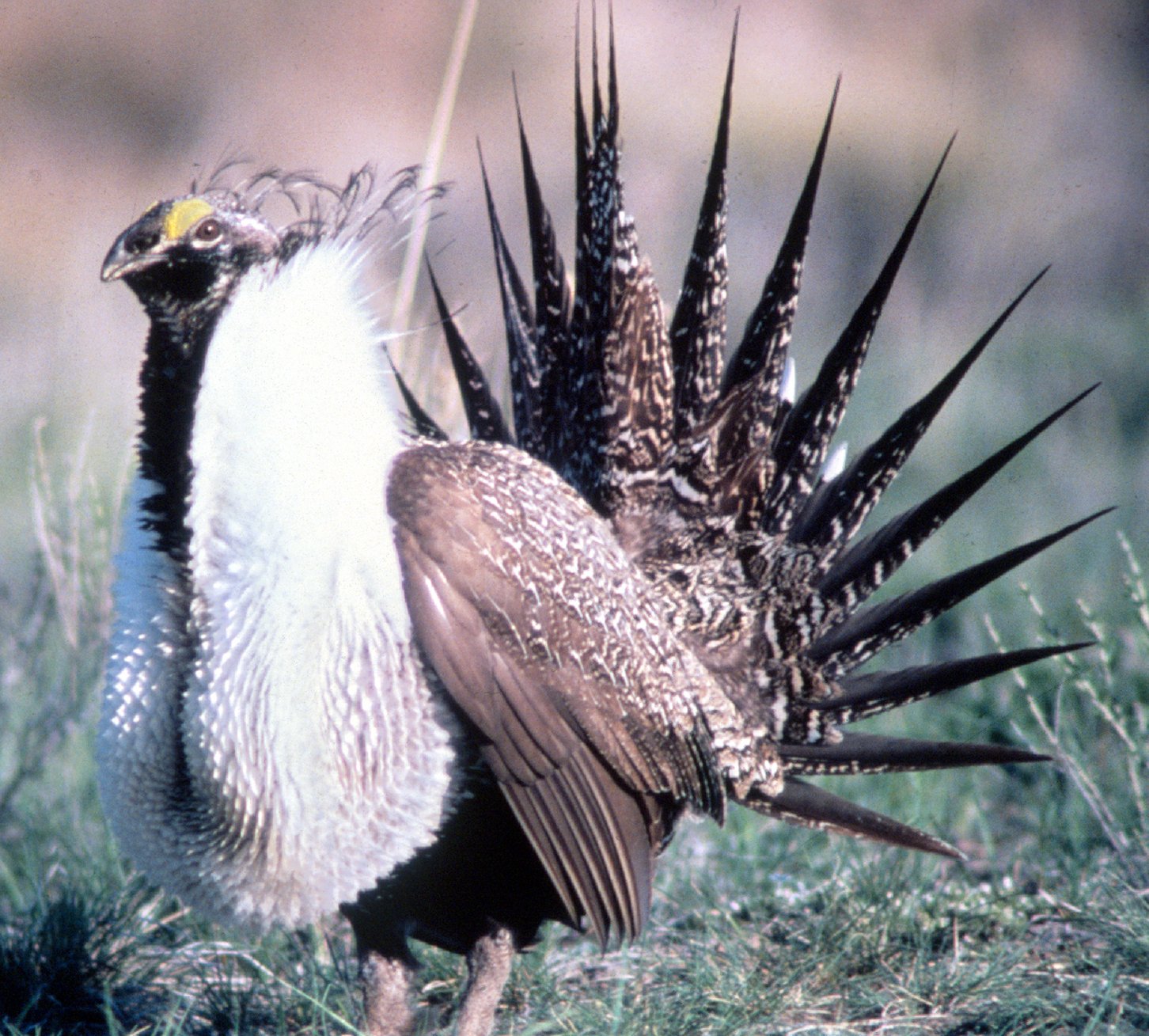- Greater Sage-grouse
Taxobox
name = Greater Sage-grouse

image_width = 220px
image_caption = Lekking male,Grand Teton National Park
status = NT
status_system = iucn3.1
regnum =Animal ia
phylum =Chordata
classis =Aves
subclassis =Neornithes
infraclassis =Neognatha
superordo =Galloanserae
ordo =Galliformes
familia =Tetraonidae (disputed)
genus = "Centrocercus "
species = "C. urophasianus"
binomial = "Centrocercus urophasianus"
binomial_authority = (Bonaparte, 1827)
subdivision_ranks =Subspecies
subdivision =
* "Centrocercus urophasianus phaios"
* "Centrocercus urophasianus urophasianus"The Greater Sage-grouse, "Centrocercus urophasianus", is the largest grouse in North America. Its range is
sagebrush country in the westernUnited States and southernAlberta andSaskatchewan ,Canada . TheGunnison Sage-grouse was recently recognized as a separatespecies [Young "et al." (2000)] , and theMono Basin population usually considered to belong to the Greater Sage-grouse may also be distinct.Adults have a long, pointed tail and legs with
feather s to the toes. Adult males have a yellow patch over the eye, are greyish on top with a white breast, a dark brown throat and a black belly; two yellowish sacs on the neck are inflated during courtship display. Adult females are mottled grey-brown with a light brown throat and dark belly.Ecology
This species is a permanent resident. Some move short distances to lower elevations for winter. These birds forage on the ground. They mainly eat sagebrush, also
insect s and other plants. They are not able to digest hardseed s like other grouse. They nest on the ground under sagebrush or grass patches.Sage-grouse are notable for their elaborate courtship rituals. Each spring males congregate on leks and perform a "strutting display". Groups of females observe these displays and select the most attractive males to mate with. Only a few males do most of the breeding. Males perform on leks for several hours in the early morning and evening during the spring months. Leks are generally open areas adjacent to dense sagebrush stands, and the same lek may be used by grouse for decades.
tatus
The numbers of this species are declining due to loss of habitat; their range has shrunk in historical times, having been extirpated from
British Columbia ,Kansas ,Nebraska ,Oklahoma ,Arizona andNew Mexico . Though the Greater Sage-grouse as a whole is not considered endangered by theIUCN , local populations may well be so. This species have been petitoned for listing under the Endangered Species Act. However, the US Fish & Wildlife Service, for political reasons [Chief US District Judge Winmill (2007)] , has refused to list them. In May 2000, the CanadianSpecies at Risk Act listed the "Centrocercus urophasianus phaios", formerly found inBritish Columbia , as being extirpated inCanada [Environment Canada (2006)] .The Greater Sage-grouse is probably quite vulnerable to the change towards more
humid climate caused byglobal warming , which would reduce thesemiarid sagebrush habitat.Subfossil bones e.g. fromConkling Cave andShelter Cave of southern New Mexico prove that the species was present south of its current range at the end of thelast ice age [Howard (1933)] .Footnotes
References
*|year=2004|id=47089|title=Centrocercus urophasianus|downloaded=09 November 2007
* (2004): "Conservation Assessment of Greater Sage-grouse and Sagebrush Habitats". Unpublished Report, Western Association of Fish and Wildlife Agencies. Cheyenne, Wyoming. [http://www.ndow.org/wild/conservation/sg/resources/greate_sg_cons_assessment.pdf PDf fulltext]
* (2006): [http://www.speciesatrisk.gc.ca/search/speciesDetails_e.cfm?SpeciesID=291 Species at Risk - Greater Sage-Grouse "phaios" subspecies] . Version of 2006-MAY-08. Retrieved 2007-NOV-09.
* (1933): Bird remains from cave deposits in New Mexico. "Condor" 35(1): 15-18. [http://elibrary.unm.edu/sora/Condor/files/issues/v035n01/p0015-p0018.pdf PDF fulltext] [http://elibrary.unm.edu/sora/Condor/files/DJVU/v035n01/P0015-P0018.djvu DjVu fulltext]
* (2000): A new species of sage-grouse (Phasianidae: "Centrocercus") from southwestern Colorado. "Wilson Bulletin " 112(4): 445-453. DOI:10.1676/0043-5643(2000)112 [0445:ANSOSG] 2.0.CO;2 [http://www.bioone.org/perlserv/?request=get-abstract&doi=10.1676%2F0043-5643(2000)112%5B0445%3AANSOSG%5D2.0.CO%3B2 HTML abstract]
*"Western Watersheds Project v. U.S. Fish and Wildlife Service" - Summary Judgement [http://www.westernwatersheds.org/legal/07/sagegrouse/greater_sage-grouse_sj_decision.pdf PDF fulltext]External links
* [http://www.birds.cornell.edu/AllAboutBirds/BirdGuide/Greater_Sage-Grouse.html Cornell Lab of Ornithology - Greater Sage Grouse]
* [http://www.mbr-pwrc.usgs.gov/id/framlst/i3090id.html USGS Patuxent Bird Identification InfoCenter - Greater Sage Grouse]
* [http://enature.com/fieldguides/detail.asp?allSpecies=y&searchText=greater%20sage%20grouse&curGroupID=1&lgfromWhere=&curPageNum=1 eNature.com: Greater Sage Grouse]
* [http://sdakotabirds.com/species/greater_sage_grouse_info.htm South Dakota Birds and Birding - Greater Sage Grouse]
* [http://vireo.acnatsci.org/search.html?Form=Search&SEARCHBY=Common&KEYWORDS=Sage-grouse&showwhat=images&AGE=All&SEX=All&ACT=All&Search=Search&VIEW=All&ORIENTATION=All&RESULTS=24 "Greater Sage-Grouse" photo gallery] VIREO
Wikimedia Foundation. 2010.
